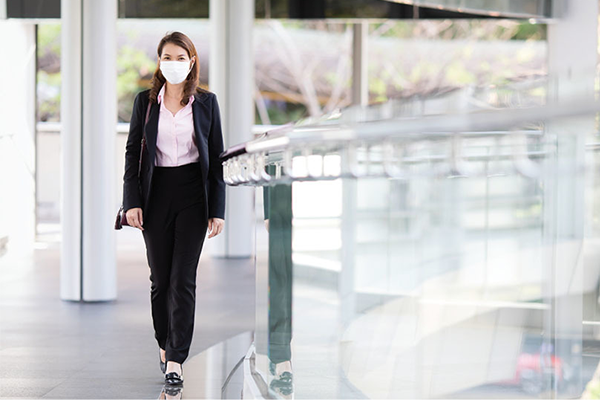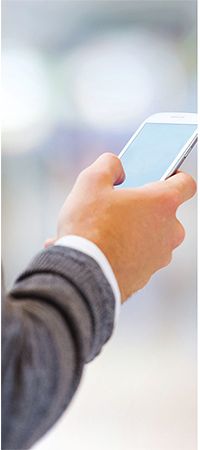
Businesses worldwide continue to rethink their operations as the COVID-19 pandemic rages on. Slowly, employees are returning to their places of business, while not totally abandoning their home offices. The dilemma now facing occupiers is how to continue this population shift safely and efficiently and return to some type of normalcy. While the advantages of remote working have been made clear, there are still many employees who want the in-office experience of camaraderie, collaboration and company culture — elements that have been sorely missed since March. In addition, much has been written about the advantages of employees working under one roof when it comes to productivity, recruiting and training. Companies are looking to ease cautiously back into the office — whether full time or in a hybrid model.
That’s good news for building owners and managers, who are working to provide a smooth, safe return for their tenants. Some occupants will undoubtedly be hesitant about returning to the office in the near term and have questions around everything from heating, ventilating and air-conditioning (HVAC) systems to cleaning protocols. So, what are property managers doing as they accommodate tenants’ Great Return, and what technologies are helping them in that process?
Tech Advancement On Steroids
The use of technology was already in play pre-COVID-19, of course, but the pandemic has accelerated the need. "When tenants walk into their building, it’s obviously going to look different than it did when they left it more than six months ago," says Doug Stewart, head of Cushman & Wakefield’s Digital Buildings practice.
To ease the increased complexity of moving in and around a building, such applications as touchless kiosks to scan people’s temperatures and digital ID badges on smartphones will ease access to specific elevators and floors.
Obviously, cramming into elevators as tenants did pre-pandemic isn’t going to cut it in a world of social distancing. To monitor and control elevator density, simply reducing maximum weight capacities can result in fewer passengers. Once capacity is reached, the elevator will no longer work, according to Mark Zettl, president of JLL’s Property Management Group, which has deployed such an approach in many of the firm’s buildings.
In addition, JLL has implemented mobile phone apps that provide touchless controls that are voice-activated for use in the lobby or elevator car. Another innovation: antibacterial ultraviolet (UV) light that can remove 99 percent of the bacteria in the elevator. The lights are installed on the cabin ceiling and can sterilize the car while the elevator is empty. There’s also the use of destination dispatch, an optimization technique that can improve elevator travel time by grouping passengers headed for the same floors.
When tenants walk into their building, it's obviously going to look different than it did when they left it more than six months ago."
—Doug Stewart, Cushman & Wakefield

Building owners and managers are considering a variety of other technologies to further promote health, safety and social distancing and, in doing so, instill trust among tenants. Indoor air quality, for example, is crucial. Even before concerns about COVID-19, air quality was an increasing consideration for tenants. Now, in addition to the importance of increasing ventilation in the building and bringing in more fresh air, there are technologies that can help reduce the risk of infectious disease transmission in buildings.
For instance, some building owners are installing particle monitoring to determine air quality. By measuring the concentration of airborne particles, carbon dioxide levels and humidity, a building operations team is alerted if airflow needs to be adjusted or if tenants need to vacate certain areas of a building. There are also air filtration technologies like bipolar ionization, which helps capture such harmful contaminants as viruses, mold, allergens and bacteria via positively and negatively charged oxygen ions.
Touchless technology, as in the elevators, may help occupants gain confidence once they’re beyond the lobby as well. Contact-free fixtures include automatic faucets, soap and paper towel dispensers and touchless breakroom refrigerators and door sensors.
"While it may vary from building to building, touchless technology to reduce the spread of germs has been widely implemented," says JLL’s Zettl. That includes touchless hand-sanitizer stations in lobbies, parking facilities, near restrooms and in common areas.
Too Close For Comfort?
JLL and other companies are utilizing technology for density monitoring in different floors and heavily trafficked spaces. "We can install cameras or overhead sensors that use active infrared and time-of-flight technology to detect when someone passes them," Zettl explains. "People are counted as they walk beneath the unit. Devices can alert our staff when occupancy reaches unsafe levels. They can also give our tenants the ability to subscribe to alerts."
In addition, employee movements can be tracked through their own smartphones. Signals sent from other wireless devices can be used to track area concentrations, warning users of potential crowding. However, since this method relies on the accuracy of individuals having devices turned on and physically on their bodies at the time of tracking, it’s not 100 percent accurate, according to Zettl.
"There’s a lot we can do from a technology perspective, but this also is a human behavior conversation, and there are a lot of policies and practices that have to come along with that."
Sensors measuring room occupancy are also increasingly recognized as critical, Stewart points out. However, he agrees that it’s difficult to change human behavior because people like to interact. "The technology may alert somebody, but who’s going to enforce it?" he asks. "What if I’m that person who just walks up to everybody? I sit on your desk, and I’m two-and-a-half feet from you. I can have all the tracking devices I want, but somebody has to say you can’t do that. There’s a lot we can do from a technology perspective, but this also is a human behavior conversation, and there are a lot of policies and practices that have to come along with that."
The same can be said for wireless key fobs that track movements and interactions with coworkers. A sensor on the device alerts people if they’re too close to one another. These can be used for contact tracing if someone contracts the virus as well.
Many companies are adopting scheduling tools to limit how many people can be in an office at one time, letting them schedule use of various amenities or conference rooms. Zettl says there are currently multiple software solutions that have the ability to book common-area amenities, as well as standalone scheduling tools that can be used to create and publish schedules and allow third parties to book time.
Big App Uptick

Of course, mobile tenant apps were a trend pre-COVID-19, but, as with virtually all building technologies, there’s been a big uptick due to the increasing need for communication. Tenant employees, for example, can use apps to see who else will be in the office and decide when or whether they’re going in based on that information.
"I’m getting ready in the morning and I pull up the app for my building," Stewart explains, "and it says, 'Bad day. Don’t come in.’ Fine. I take my coffee and go log in downstairs. Or it says, ‘We’re fully open. There’s a 30 percent capacity, and space is available. The line to get into the building is only two minutes.’"
Stewart notes that even coffee breaks or trips to the restroom are being reevaluated during the pandemic. Companies might have 10-minute time slots for employees to grab coffee at the café. Some buildings are limiting restrooms to one person at a time, with red lights and green to indicate occupancy. "We have to communicate all of that to the tenants so they feel comfortable," Stewart adds. "If they don’t feel comfortable, they’re not necessarily going to go back to the office."
Confidence at Your Fingertips?
TranswesternHub is live at 77 West Wacker Drive, a Class A commercial office building in Chicago’s Loop. It also will be available as an option to deploy across Transwestern’s roughly 130 million square feet of managed office space throughout the United States. "Tenants can expect to see an increase in proptech as they return to the office," says Katie Sakach, LEED AP O+M, managing director of Asset Services at Transwestern.
When implementing the solution at 77 West Wacker, she indicates that the company was mindful that not every building is the same. While a technology might work for one property, it may not necessarily work for another.
Transwestern’s 77 West Wacker was built in the 1990s, so many of its systems have been in place for some time. "We applied this pilot platform to existing systems in the building, because we see similar types of systems employed in most office product across the country," Sakach explains. "We worked to deploy a customized tool specific for the systems in place at 77 West Wacker to create the ultimate tenant experience."
"Your keycard interacts with the card access system at the building via Bluetooth so you don’t have to touch anything," shares Jake Smith, CPM, vice president and director of Operations in Asset Services for Transwestern. "It’s the same with elevator call buttons. You just pull up the app and enter which space you want to visit."
Building visitors receive a QR code on their devices. When they arrive, they scan it using a touchless reader and gain access into the building, elevator and their destination space.
"One of the things I was most attracted to with the platform was the opportunity to reduce the number of touchpoints for the tenants, management team and engineers," reveals Smith. "They don’t have to have three different apps to do the things that they need to do, like scheduling HVAC service, reserving a conference room or engaging with visitors."
ABOUT THE AUTHOR: Liz Wolf is a Twin Cities-based freelance writer with 30-plus years of business and commercial real estate reporting experience. She previously served as editor of the Minnesota Real Estate Journal.